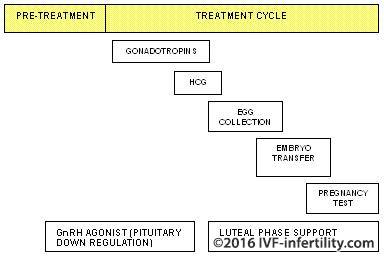What is involved in IVF treatment?

Conventional or standard IVF treatment involves the administration of fertility drugs, monitoring of the cycle, collection of eggs, mixing eggs and sperm together outside the woman's body in a culture dish or test-tube. Any resulting embryos are left to grow and the best 1-3 embryos are then transferred into the woman's womb. Any remaining embryos of good quality may then be frozen for future use.
What is IVF cycle?
The diagram below summarises the IVF cycle.

IVF cycle consists of several steps over an interval of 4-6 weeks and start when a woman begins taking drugs to stimulate her ovaries to produce eggs, monitoring progress by ultrasound scan and blood tests, collecting eggs, collecting man’s sperm, fertilizing the eggs, transferring the embryo into the womb and end by the pregnancy test.
The original indication for IVF was tubal damage, but it is now used for a wide range of disorders such as unexplained infertility, endometriosis, male factor infertility, failure to conceive after 12 cycles of successful ovulation induction, failure to conceive after 4-6 cycles of intrauterine insemination etc.
The table below illustrates what would happen if 100 patients in various age groups commenced IVF treatment using their own eggs.
Age group |
Younger than 35 |
35-37 |
38-40 |
41-42 |
Over 42 |
No IVF cycles started |
100 |
100 |
100 |
100 |
100 |
No Egg collections |
92 |
88 |
85 |
81 |
78 |
No Embryo transfers |
86 |
82 |
78 |
71 |
64 |
No pregnancies |
43 |
36 |
27 |
18 |
8 |
No Live births |
37 |
29 |
20 |
11 |
4 |
Data adapted from SART 2005 Report.
How IVF is carried out?, What is the success rates? What are the complications of IVF, and how they can be prevented, What is ICSI etc, will be discussed in the following pages.